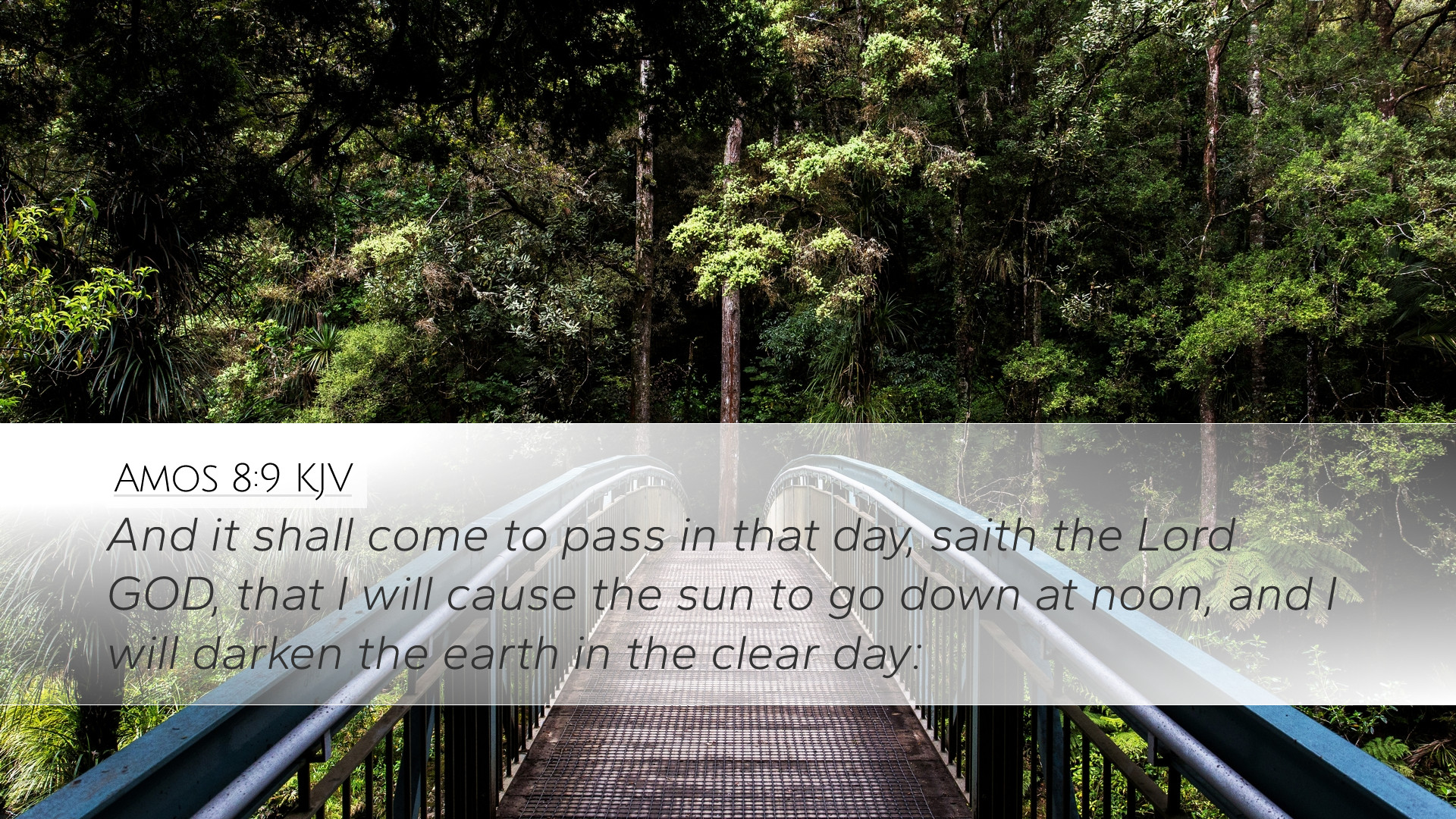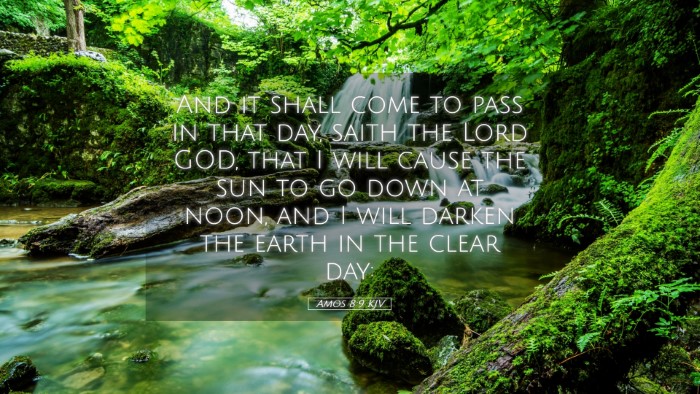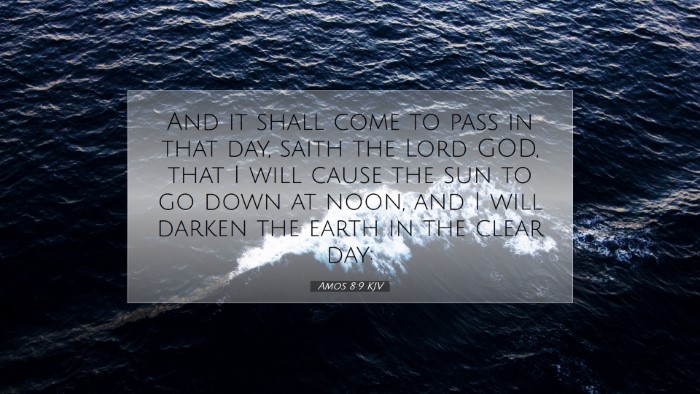Old Testament
Genesis Exodus Leviticus Numbers Deuteronomy Joshua Judges Ruth 1 Samuel 2 Samuel 1 Kings 2 Kings 1 Chronicles 2 Chronicles Ezra Nehemiah Esther Job Psalms Proverbs Ecclesiastes Song of Solomon Isaiah Jeremiah Lamentations Ezekiel Daniel Hosea Joel Amos Obadiah Jonah Micah Nahum Habakkuk Zephaniah Haggai Zechariah MalachiAmos 8:9
Amos 8:9 KJV
And it shall come to pass in that day, saith the Lord GOD, that I will cause the sun to go down at noon, and I will darken the earth in the clear day:
Amos 8:9 Bible Commentary
Commentary on Amos 8:9
Amos 8:9 states, "And it shall come to pass in that day," saith the Lord God, "that I will cause the sun to go down at noon, and I will darken the earth in the clear day." This verse, being a part of Amos's prophetic imagery, speaks to the catastrophic consequences of Israel's socio-religious injustices. To understand its implications, we will distill insights from various public domain commentaries.
General Context
The book of Amos is a profound proclamation against the Northern Kingdom of Israel. Amos, a shepherd and farmer turned prophet, begins with a message warning Israel of impending judgment due to their failure to uphold justice and righteousness. This verse falls within a broader theme of divine retribution for their transgressions.
Insights from Matthew Henry
Matthew Henry comments extensively on the theme of divine judgment woven throughout the prophetic texts. He asserts that the imagery of the sun going down at noon signifies an abrupt cessation of prosperity and the revelation of impending doom. Here are the key points from Henry’s exposition:
- Symbolism of Darkness: Darkness in biblical literature often symbolizes judgment. Henry interprets this impending darkness as God's withdrawal of favor from Israel.
- Contrast with Daylight: The "clear day" juxtaposed with imminent darkness underlines the unexpected nature of divine judgment. Such a day heralds clarity of thought before apostasy leads to devastation.
- Historical Implications: Henry relates this prophecy to Israel’s historical events, where times of plenty led to apathy and moral decay, culminating in God’s judgment.
Insights from Albert Barnes
Albert Barnes provides a more detailed theological exposition regarding the imagery presented in Amos 8:9. His interpretations underscore the gravity of the sins committed by Israel:
- Day of the Lord: Barnes correlates this passage with the “Day of the Lord,” indicating a time of reckoning. The metaphor of the sun darkened at noon reflects a complete reversal of normalcy—a sign of unusually severe judgment.
- Call to Repentance: Barnes views Amos's prophecies as both a warning and a call for Israel to repent and return to God. The imminent darkness is a metaphor for their spiritual blindness in failing to heed divine instruction.
- Natural and Spiritual Darkness: He posits that just as the physical sun may be obscured, a spiritual obfuscation has taken over the hearts of the Israelites, leading them slightly away from true worship and ethical conduct.
Insights from Adam Clarke
The commentary by Adam Clarke offers a deeper theological reflection on the nature of God's judgment and its symbolism in Amos 8:9:
- Miraculous Nature of Judgment: Clarke emphasizes that the darkening of the sun at noon points to a miraculous intervention by God. This is not a mere earthly phenomenon but an act that signifies divine displeasure.
- National Consequences: He elaborates on the national ramifications of this prophecy, indicating that the darkening represents the desolation that will ensue among God's people, impacting their lands, livelihoods, and general stability.
- Symbol of Hopelessness: The sudden onset of darkness serves as a symbol of hopelessness for a nation that has strayed far from the covenant it once held dear. Clarke admonishes that recognizing such prophecies is crucial for both ancient and modern audiences.
Theological Implications
The combined insights from these commentators present profound theological implications relevant to contemporary audiences:
- God’s Sovereignty in Judgement: Understanding that God remains sovereign and in control, even amidst societal decay, reinforces the need for repentance and alignment with divine principles.
- Call to Vigilance: The imagery serves as a warning for current believers to remain vigilant in their faith and practices, ensuring that they do not stray into complacency like the Israelites of old.
- Hope Amidst Judgment: While the darkness signifies judgment, it also calls for a return to righteousness, creating an opportunity for restoration and renewed relationship with God.
Conclusion
Amos 8:9 encapsulates a critical message about the nature of divine judgment and the profound consequences of societal sin. The insights provided by Matthew Henry, Albert Barnes, and Adam Clarke converge on central themes of accountability, the swift transformation from light to darkness, and the urgent call for repentance. As pastors, students, theologians, and Bible scholars engage with this verse, they are encouraged to reflect on both the historical context and the enduring relevance of its message today.


